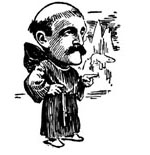
Monasticism Meets the Twenty-First Century
THE COMMODIFICATION OF QUIET
Kicking off the New Year, The New York Times ran two similar articles, one in the Travel section, the other in the Sunday Review section (Jan. 1). Both were written by busy professional writers who had sought out a few days of silence at Catholic religious houses. In the Travel feature, Susan Gregory Thomas reflected on her stay at the Jesuit Center in Wernersville, Pennsylvania. In the Sunday Review feature, Pico Iyer wrote of his retreats at a Benedictine hermitage near Big Sur, California. Both articles point to a phenomenon much discussed by monks and nuns these days — namely, the growing number of busy, middle-class people who are drawn to aspects of the monastic experience, and the shrinking number of people who actually enter into monastic life. To give a concrete example: In 1970 the American-Cassinese Congregation of Benedictine monks had 1,830 members; in 2012 the number was 793. Similar figures could be supplied for the other congregations within the order.
The titles of the two Times articles are revealing. Thomas’s is entitled “A Quick Shot of Peace, on a Budget”; Iyer’s is called “The Joy of Quiet.” The implication of Thomas’s title is that Catholic spiritual life as formalized in monasteries has become a luxury to be rented, a weekend indulgence; Iyer’s title, whether chosen by him or by an editor, alludes to a bestseller from the 1970s, The Joy of Sex. That nod to the 1970s provides a clue, for two TV sitcoms in that era, Green Acres in the U.S. and The Good Life in the U.K., portrayed urban professionals who chose to quit the rat race of the city and live simple lives on a farm. While the characters were meant to be comical, they also appealed to a widespread desire among viewers to slow down and simplify, to get off the merry-go-round of modern life.
Still, the 1970s has been criticized as the “Me Decade,” and adopting a simple country life became, paradoxically, yet another form of pampering oneself. Iyer realizes this. Of his own decision to avoid the preponderance of gadgets such as iPads and trends such as Facebook by moving from Manhattan to rural Japan, he writes that it is not “a matter of principle or asceticism; it’s just pure selfishness.” Calculating how to slip away even for a few days into silence and simplicity is itself a symptom of anxiety amid sensual comfort.
Meanwhile, the men and women who do seek out monasticism as a way of life, to which they commit themselves by means of canonical vows, tend to come from the same hectic, prosperous, and — alas — narcissistic world as the weekend retreatants. Whereas fifty years ago a novice was told that one of the hardships of the first year would be the restriction on receiving letters from his parents, now the appalling news is that he must not bring his laptop or cell phone. Fifty years ago, monasteries had to be wary of young men who had read too much Thomas Merton and were looking for a place where they could gaze out the window and write mellow musings on prayer and the interior life. Now, the new generation comprises young men who may have heard funny stories about Merton as a quasi-Buddhist but who are earnestly looking for a corner of the property where they can get a clear WiFi signal.
You May Also Enjoy
The Pope plainly stated, "To kill in the name of God is satanic," but again he studiously avoided identifying Muslim terrorists as perpetrators of this.
Mom Rock... Ph.D. in Air Guitar... Something to Do... Silicone Junkies... "Deferred Success"... Locker-Room Discrimination... Hey Wait...It's Art!
Community Without Boundaries?... Of Saints & Social Structures... The Other Side Of War

